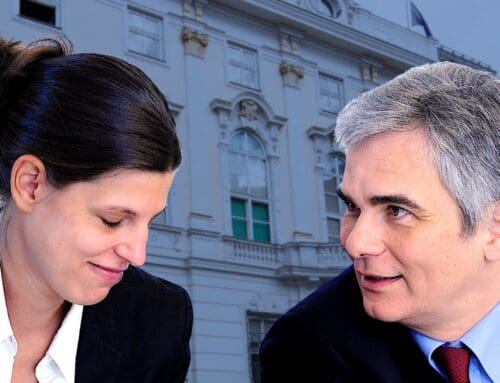
Impact Investing – The UN’s Global Social Credit System
Social finance or impact investing reduces human beings to the status of potential investments, sources of profit for wealthy ruling vampires, Winter Oak surmised. It is a digital slave trade. It wants to own and control us – our bodies and every moment of our lives – and it wants to own and control every square inch of our world.
Impact investing is a sinister industry which, over the last few years of research, we have found lurking under every dubious stone we have turned, wrote Winter Oak. Extinction Rebellion, Ronald Cohen, intersectionality, the WEF Global Shapers, Guerrilla Foundation and Edge Fund are some examples where it’ll be found.
Profiteering from “impact” is very much tied in with The Great Reset and the Fourth Industrial Revolution which aims to set up the infrastructure through which this new form of digital serfdom can be imposed. Students of history will recall that this “partnership” between the public and the private, this merger of state and big business, was the economic basis of fascism, wrote Winter Oak, and fascist economic policies were all in the interests of the ruling class.
Let’s not lose touch…Your Government and Big Tech are actively trying to censor the information reported by The Exposé to serve their own needs. Subscribe now to make sure you receive the latest uncensored news in your inbox…
Background to Impact Investing
In 2006, the United Nations Principles for Responsible Investment (PRI) was released with 63 signatories and $6.5 trillion in assets. PRI promotes the incorporation of environmental, social, and corporate governance factors (“ESG”) into investment decision-making. According to Investopedia, by 2021, PRI had over 3,800 signatories and over $121 trillion in assets.
According to the Rockefeller Foundation, by 2007 a variety of financial “innovators” had developed approaches to “socially-conscious investment” because there was a “growing demand for investment that sought some combination of financial and social outcomes.”
The Global Sustainable Investment Alliance (GSIA), a consortium of international sustainable investment organisations, issued its inaugural issue of the Global Sustainable Investment Review in 2012. In 2013, then-UK Prime Minister David Cameron gave a speech on impact investing:
We need social investment markets, social investment bonds and social investment banks … I am proud that Britain has led the way from the outset. We have created the first social impact bond – with more of these bonds in the UK today than in the rest of the world put together. We had the first charity bond too. And last year, I think our proudest creation yet, the first ever wholesale social investment bank – Big Society Capital.
We took – not just some but – all the dormant funds from banks, together with further contributions, to provide a pot of £600 million to invest … we asked Sir Ronnie Cohen – the grandfather of social investment – to chair [Big Society Capital].
Today we are announcing three major new steps. Tax breaks for social investments. A Social Stock Exchange to measure how successful those social investments are. And most importantly, new help for our communities to buy local assets.
Social investment can be a great force for social change on the planet.
Prime Minister: “social investment can be a great force for social change”, Social Impact Investment Forum, London, 6 June 2013
Further reading:
- Ronald Cohen, Impact Capitalism and The Great Reset, Winter Oak, 27 January 2021
- Impactor Alert! Winter Oak, 16 March 2021
ESG focuses on how companies assess and manage ESG risks and, looking back, it was a mechanism to get organisations used to the idea of complying with rules set at a global level. In a 2019 article, Forbes noted a case in Australia where a member of a pension fund was suing the board for failing to take into consideration climate risk in the risk profile of their portfolio. “This is not an isolated incident,” Forbes noted, “fourteen UK funds were warned by their lawyers that they risk legal action and US funds have also been urged to be more climate-sensitive.”
However, impact investing takes it to a whole new level as it focuses on using capital to effect social or environmental change. In short, it is a way to force organisations and its employees to behave in a certain way – organisations that do not follow the rules do not receive investment. And the rules impact investing forces organisations to adhere to are Agenda 2030’s goals.
One of the major players in the impact investing industry is Global Impact Investing Network (“GIIN”) through its investment management tool IRIS+.
Global Impact Investing Network
USAid, UKAid, Australian Government and The Rockefeller Institute are among the lead supporters of GIIN. Based in New York, it was founded in 2009 and is a “non-profit organisation dedicated to increasing the scale and effectiveness of impact investing” by producing tools and resources such as education, research. One of the tools it has developed is a database, IRIS+, for measuring, managing, and optimising “impact.”
GIIN is proactively establishing strategic alliances around the world and has already built partnerships with the following entities:
- Asian Venture Philanthropy Network (33 countries)
- Aspen Network of Development Entrepreneurs (Global with headquarters in Washington, USA)
- The Global Steering Group for Impact Investment (35 countries, based in the UK)
- GenderSmart (“gender-smart financing” in 50 countries, founded by Suzanne Biegel and Darian Rodriguez Heyman)
- Impact Investors Council (India)
- Investors’ Circle (the link to this organisation on GIIN’s website is broken)
- Mission Investors Exchange (USA)
- Toniic (500 high net wealth individuals in 25 countries)
- YPO (community of 30,000 “top” chief executives in 142 countries with a combined revenue of $9 trillion)
The intention of impact investment, GIIN states, is to generate “positive, measurable social and environmental impact alongside a financial return.” We’ve highlighted the obviously alarming ideology behind its intention. “Measurable” is notable because to be able to measure something, first rules have to be put in place to measure performance against. As for “positive,” it seems pointless asking positive for whom, as coupled with “a financial return” the answer is obvious.
GIIN has a network of more than 35,000 individuals and more than 350 member organisations. As of June 2020, the impact investing market was estimated to be USD 715 billion. This is expected to grow to $1 trillion by 2025.
Wikipedia has a page dedicated to a list of notable impact investing organisations. The names that appear on the list are not surprising and include Bill Gates and George Soros, read HERE.
In June 2021, GIIN joined the Finance in Common System (“FiCS”). FiCS was launched in November 2020 when 450 public development banks (“PDBs”) gathered for the first time to form a coalition which aims, by mobilising PDBs and others from private sector to civil society organisations, to align financial flows on Agenda 2030’s Sustainable Development Goals (“SDGs”) and the Paris Agreement for Climate Change.
With GIIN joining the FiCS, deeper public-private collaborations to achieve the [ ] commitments will unfold, based on a common “sustainability language”, and SDG-aligned innovative tools, ranging blended finance, green, social and SDG bonds, and debt and equity instruments. These frontiers will be central to the second edition of the FiCS, later in 2021, during which all participants are determined to make the 2030 Agenda the new norm of the global financial system.
The Global Impact Investing Network (GIIN) Joins the Finance in Common Initiative, Proparco Groupe AFD, 1 June 2021
Who founded GIIN?
A 2019 Forbes article noted Amit Bouri as GIIN’s co-founder and CEO. GIIN’s website confirms the same:
Amit co-founded the GIIN in 2009, following the launch of the Monitor Institute’s, Investing for Social and Environmental Impact, a landmark report, which he helped to conceive and develop. His work would eventually lead to the growth of a global network around the concept of impact investing and provide a blueprint that would seed the GIIN’s creation.
Who leads the GIIN? Global Impact Investing Network
However, the Rockefeller Foundation website details a different story.
Antony Bugg-Levine joined The Rockefeller Foundation in 2007 and was asked to evaluate its impact investing portfolio. Bugg-Levine then made the case that The Rockefeller Foundation should launch an initiative with the goal of accelerating the building of a network, and the Board of Directors agreed. He held a convening in the summer of 2007 to test the attractiveness of his idea with a sampling of the various actors working in the market.
Working with Monitor Institute, Bugg-Levine followed through with a second convening in 2008 that gathered an expanded group of 40 participants, representing a wider swath of the marketplace … The first step that The Rockefeller Foundation took in scaling the network was to develop a clear vision for the field that reflected the views of the network’s current participants … He was able to do that by providing lead funding for Monitor Institute to create Investing for Social and Environmental Impact: A Design for Catalysing an Emerging Industry. That research began in 2008, informed the dialogue and framed key questions at the 2008 convening.
Scaling up meant that this [impact investing] initiative had to transition from an effort led by the [Rockefeller] Foundation to an effort led and owned by its participants, and supported by a larger group of funders. That logic justified the Foundation playing a behind-the-scenes role, making its involvement as invisible as possible … The Foundation also chose not to use the Rockefeller name, branding it the Global Impact Investing Network (GIIN).
Building a backbone to accelerate impact investing, The Global Impact Investing Network, Rockefeller Foundation
Antony Bugg-Levine is a member of GIIN’s board of directors.
Should the Rockefeller Foundation’s website page also become “invisible,” we have taken the precaution of downloading a copy and attaching it below.
The desire to remain invisible seems to be summed up 8 years later in a response to a question during an interview to mark 10 years of impact investing: “Who were the people who came to the table for the impact investing conversations in those early days?”
Nick O’Donohoe replied: “It was a group of really smart thoughtful people. Some very credible institutions and organisations. There was no obvious reason to believe that this movement was going to take off, but I remember just sort of feeling that this is potentially a really transformational movement. Even though it was tiny at the time, there was nothing to invest in, there was just a handful of players, but you still felt that ‘there is a big idea here’.”
O’Donohoe is the Chief Executive Officer of CDC Group, the UK government’s development finance institution. Prior to his role at CDC Group, O’Donohoe served as Senior Adviser for Blended Finance at the Bill & Melinda Gates Foundation. Between 2011 and 2016, he served as the founding Chief Executive of Big Society Capital. He also helped to produce the blueprint for the government-backed social investment wholesaler and became its chief executive when the organisation was launched. Prior to that O’Donohoe was Global Head of Research at JP Morgan.
Big Society Capital was founded in 2012 and received an injection of capital by David Cameron in 2013 with “all the dormant funds from banks.”
Impact Investing in the UK
As one of the lead supporters of GIIN, UKAid under its Direct Impact grants supports civil society organisations in countries considered to be of “high and moderate fragility” and the 50 lowest countries in the Human Development Index, “where support for achieving the Global Goals is most needed.” The Global Goals are the 17 SDGs the United Nations want to achieve by 2030. UKAid’s grants target countries outside the UK.
To accelerate the growth of the impact investing market within the UK, in 2019, the Impact Investing Institute was launched which brought together two influential initiatives: the Government’s Taskforce for Growing a Culture of Social Impact Investing in the UK and the UK National Advisory Board on Impact Investing. Core funders of the Institute are the City of London and UK Dept for Digital, Culture, Media and Sport.
Dame Elizabeth Corley is the chair of the Impact Investing Initiative. In 2021 she spoke about the aims and objectives of the Institute and the “myth” that impact investing means sacrificing financial return. It is no “myth” to us that profit is at the forefront of the scheme. And, not to leave out one of their most important tools, she also spoke about climate change. “The need to tackle both the environmental and social challenges of climate change to secure a just transition to a net-zero economy,” as the Impact Investing Institute put it.
We have embedded the video below to begin at the point where Corley talks about linking employee remuneration to SDGs. She specifically mentions remuneration of executives but it would be unwise to assume that’s where it would end. As is usual a lot of fluffy sounding buzz words are used with few details so we are left guessing what this would mean practically. But, it sounds suspiciously like a social credit system where renumeration depends, not whether work is productive but, on whether SDGs – goals set by the United Nations – are satisfied.










